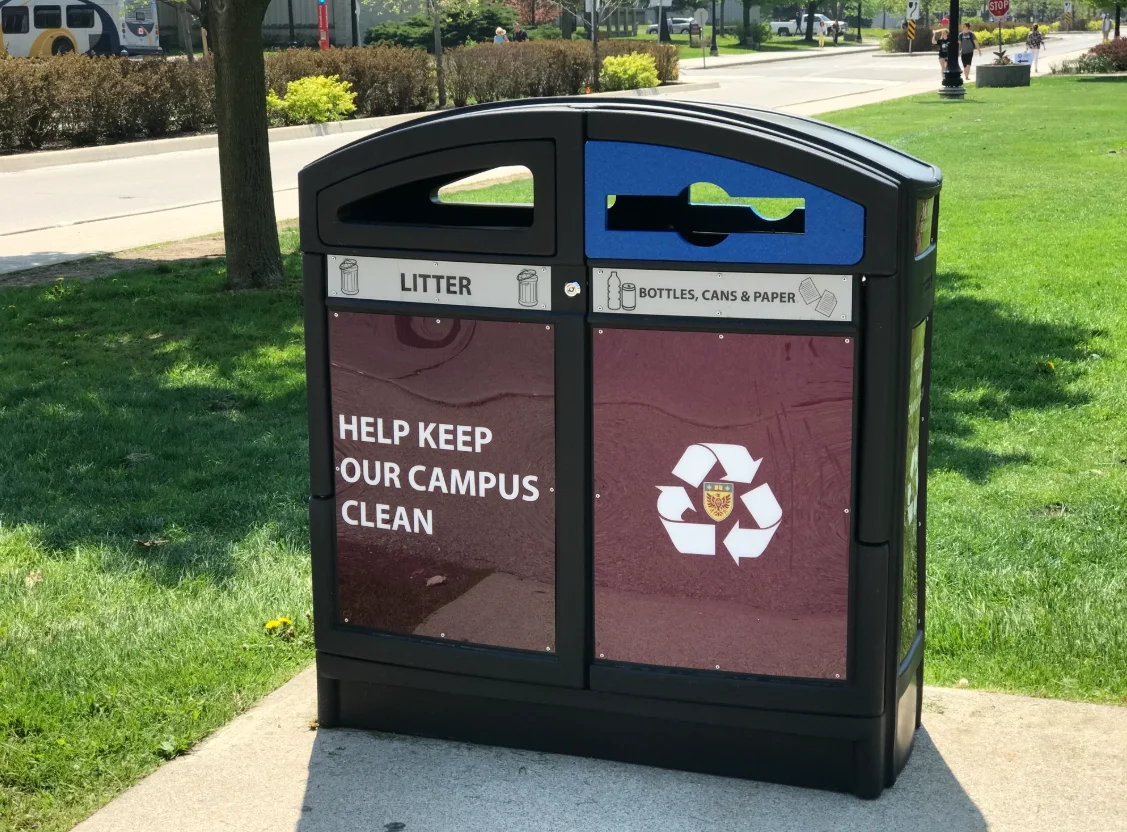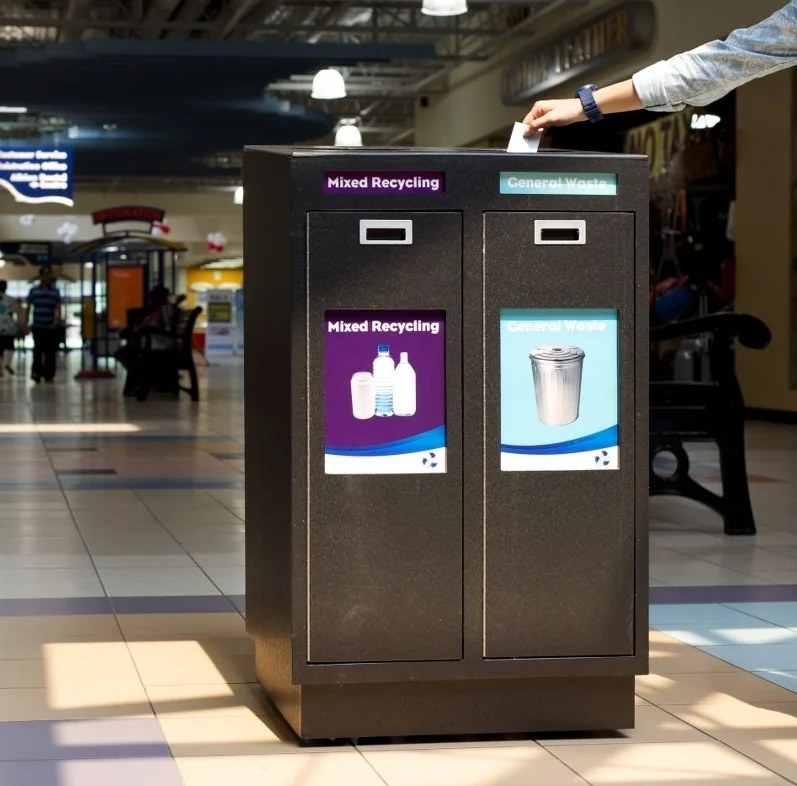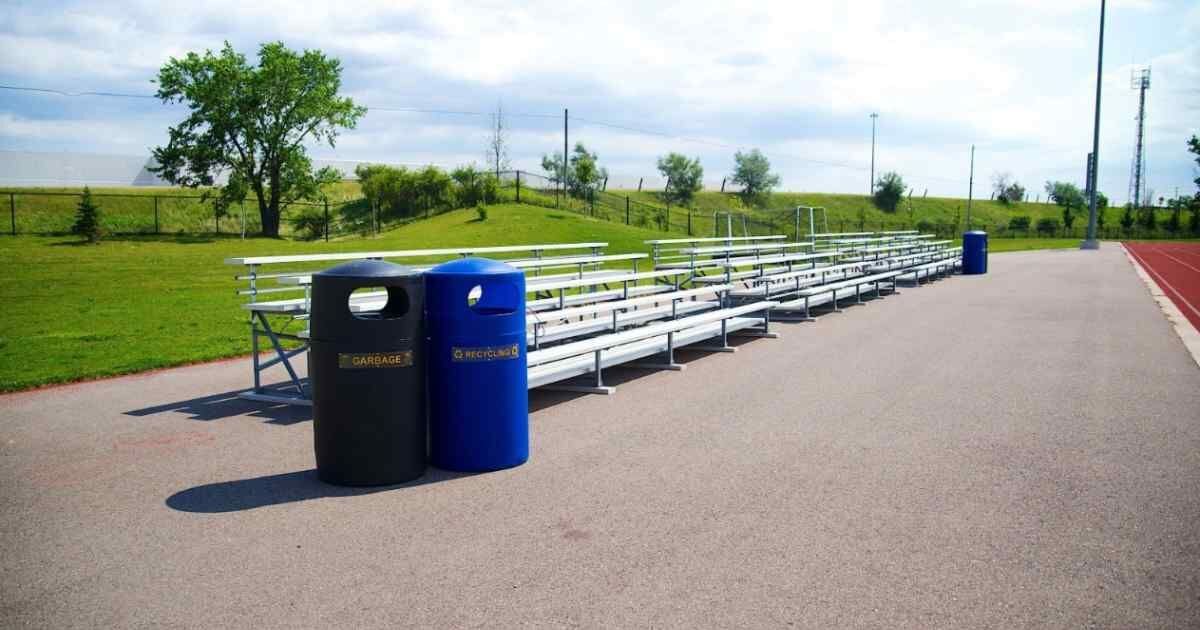
Property managers and businesses across North America spend over $11.5 billion yearly on litter cleanup, with private businesses shouldering $9.1 billion of those costs. A USA Today report highlights that the U.S. and Canada lead global waste production, emphasizing the critical need for better disposal methods.
The frustrating truth? Most litter lands mere steps from public waste bins. Morning walks reveal the evidence: coffee cups left on benches, wrappers tangled in bushes, bottles discarded near doorways – all within sight of available bins.
This cycle doesn't just drain resources; it impacts staff morale and stretches budgets thin. Rather than blaming careless visitors, research reveals the core issue lies in presentation and placement. Evidence shows that enhancing bin visibility alone decreased littering by 35%. Success doesn't require more bins – it demands making existing ones unmissable!
Research suggests that people spend less than two seconds at a waste bin. In a world where many are juggling phones, bags, or conversations, this window shrinks even further. During these brief moments, bins that blend into their surroundings might as well not exist.
Research from the University of Toronto Trash Team highlights how thoughtful bin design and strategic placement can significantly influence waste disposal habits. Their insights emphasize the importance of visibility and accessibility in reducing litter.
A Toronto Urban Design study tracked pedestrian behavior around waste bins and found:
Most people will hold onto trash for about 12 steps while actively searching for a bin.
After 15 steps, they begin considering “temporary” placements, like setting the trash on a bench or ledge.
At 20 steps, the likelihood of proper disposal drops by 90%.
These findings reinforce that when bins are hard to spot or inconveniently placed, even well-meaning individuals may resort to littering.
Some of the most frequent issues that make bins “invisible” include:
Colour Matching: Bins that are too similar in colour to surrounding buildings or landscapes.
Hidden Placement: Positioned behind landscaping, fences, or other structures.
Low Contrast: Bins that fail to stand out against their background, especially in busy urban settings.
Lack of Signage: No clear or easily readable labels to guide use.
Weather Damage: Faded paint, worn decals, or rusted materials that make bins look unappealing or unnoticeable.
Addressing these issues ensures the bins you’ve invested in actually get used. Classic Displays specializes in designing waste bins that stand out in any environment, offering solutions tailoured to high visibility needs.
The visibility of a waste bin can make or break its effectiveness. High contrast and strategic design aren’t just nice to have – they’re essential. Studies show that people recognize objects with strong colour contrast up to three times faster than those that blend into the background. So, how can you apply this to waste bins?
Stand Out, Don’t Blend In: Dark bins work well against light-coloured buildings, while brighter hues are better suited to parks or natural settings.
Think Reflectively: Reflective strips or accents make bins hard to miss, even in low-light areas like shaded paths or parking lots.
Create Visual Breaks: Colour blocking or stripes add interest and help the bin pop against its surroundings.
The height of a bin might seem trivial, but it’s a key factor in its usability. A bin that’s too low might go unnoticed, while one that’s too tall can feel awkward or obstructive.
Find the Right Height: Bins between 36-42 inches tall are easy to spot without disrupting the flow of a space.
Make Them Visible: Place bins in open areas where they can be seen from several directions – avoid tucking them behind landscaping or benches.
Be Consistent: Stick to predictable placement patterns. For example, always position bins near intersections or entrances, so users instinctively know where to look.
Clear, effective signage bridges the gap between visibility and usability. Even the most visible bin won’t be helpful if people don’t know what to do with it.
Go Universal: Icons are faster to process than words and work across languages.
Play with Contrast: Signs that use bold colours stand out better than ones that fade into the bin itself.
Think Beyond One Angle: Ensure signage is visible from multiple directions, especially where people are most likely to approach.
When these elements come together – vibrant colours, thoughtful placement, and clear signage – you create waste bins that are not only functional but impossible to overlook. The result? Cleaner spaces with less effort.
Even the most eye-catching bin will fail to serve its purpose if it’s placed in the wrong spot. Strategic placement is just as critical as design, ensuring bins are easy to locate and access during high-traffic moments.

Entry and Exit Points: People naturally look for waste bins when entering or leaving a space, especially if they’re carrying items like receipts or disposable packaging.
Seating and Rest Areas: Benches, picnic areas, and public seating zones are magnets for waste.
Food Areas: Near food trucks, vending machines, and outdoor dining setups.
Path Intersections: Crossroads in parks, sidewalks, or building walkways see heavy foot traffic and should include bins to intercept waste.
Transit Stops: Bins near bus stops or train stations reduce littering in transportation hubs.
The "50/50 Rule" remains a golden standard for public waste bin placement. People should spot a bin within 50 feet and reach it within 50 steps. Following this guideline prevents the “I’ll just set it down for now” behavior that often leads to littering.
Design and placement are only effective if bins are regularly maintained. A dirty, overflowing, or damaged bin not only discourages proper use but also creates a negative perception of the surrounding space.
Regular Emptying: Bins in high-traffic areas should follow a schedule based on footfall and peak hours.
Quick Response to Overflow: Overflowing waste attracts pests and signals neglect.
Clean Surroundings: Tidy up areas around bins to create an inviting environment.
Seasonal Cleaning: Deep clean bins to remove grime, odors, and buildup, especially after winter weather.
Repaint and Refresh: Touch up paint and replace faded decals to keep bins looking professional.
Upgrade When Necessary: Swap out outdated bins with modern options like those from Classic Displays that feature durable materials and thoughtful designs.
Clear labels and bold colour-coding take the guesswork out of waste disposal. When trash, recycling, and compost bins are placed together, and each one is marked with easy-to-read icons, people naturally make better choices. These small adjustments help keep recyclables out of landfills and ensure compostable waste goes where it belongs.
Modern bins are built to last, and many are made from materials like high-density polyethylene or recycled metals. These materials stand up to heavy use while reducing the demand for new raw resources. Choosing durable options means fewer replacements and less waste in the long run, supporting a more sustainable approach to waste management.
Thoughtful waste management practices can also help reduce the environmental impact of waste collection. For example, larger bins that hold more waste can decrease the frequency of collection trips, minimizing vehicle emissions and labor costs. Additionally, strategically planned collection routes can ensure resources are used efficiently, avoiding unnecessary trips and saving time.
Well-designed bins do more than collect waste – they also teach. Signs that say things like “Recycle Here” or “Compost Only” help people form good habits without much thought. When bins are clearly labeled and easy to use, they guide behavior while making the process feel effortless.
Even small improvements in waste bin design and placement can have a big impact. Properties that adopt smarter waste management practices aren’t just keeping spaces clean – they’re contributing to a healthier environment for everyone.
Visible, accessible, and well-maintained waste bins aren’t just about reducing litter – they help establish a culture of care and responsibility in public spaces. When visitors encounter clean, easy-to-use bins, they’re more likely to:
Dispose of waste properly.
Encourage others to use bins instead of littering.
Report issues like overflowing bins or vandalism.
Return to and recommend clean, welcoming spaces.

Making your public waste bins impossible to miss is about creating functional, user-friendly spaces where proper waste disposal feels natural. By focusing on design, placement, and maintenance, property managers and municipalities can reduce litter, lower cleanup costs, and enhance the experience for everyone who visits their spaces.
Take the first step by assessing your current setup. Are your bins visible and inviting? Are they placed where people naturally gather or walk? With thoughtful strategies, you can transform your property into a cleaner, more welcoming environment.
Partner with Classic Displays to bring these strategies to life. With our innovative waste bin designs and decades of expertise, you can make your property cleaner, greener, and more inviting.